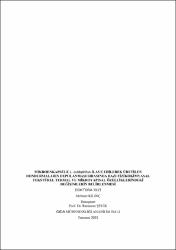Mikroenkapsüle L. acidophilus ilave edilerek üretilen dondurmaların depolanması sırasında bazı fizikokimyasal tekstürel termal ve mikroyapısal özelliklerindeki değişimlerin belirlenmesi
Özet
Son yıllarda mikroenkapsülasyon yeni bir teknoloji olarak araştırmacıların ilgisini çeken güncel araştırma konularından biridir. Mikroenkapsülasyon işleminde araştırmacıların yeni bir enkapsülasyon yöntemi ya da yeni bir kaplayıcı ajan üretme üzerine yoğunlaşmaktadırlar. Dünya’da süt ve süt ürünlerine fonksiyonel özellik kazandırılması yönünde yapılmış çalışmaların sayısı da oldukça fazladır. Bu ürünler içerisinde, besin değerinin oldukça yüksek olması ve bileşimi en kolay değiştirilebilen süt ürünlerinden biri olması sebebiyle dondurmanın da önemli bir yeri bulunmaktadır.
Bu çalışmada, liyofilizasyon tekniğiyle L. acidophilus farklı kaplama malzemeleriyle (yağlı süt tozu, yağsız süt tozu, sorbitol ve peynir altı suyu tozu) kaplanarak dondurma üretiminde kullanılmıştır. Üretilen dondurmalar depolanarak (-18 oC 90 gün) fizikokimyasal, tekstürel, termal ve mikroyapısal özellikleri takip edilmiştir. Liyofilizasyon sonrasında L. acidophilus en yüksek canlılık oranı % 92,75 ile yağlı süt tozu ile kaplanmış örneklerde belirlenmiştir. Dondurma miksinde, en yüksek firmness ve consistency değerleri yağsız süt tozu ile kaplanmış örneklerde sırasıyla 41,96 g ve 58,65 g.s olarak ölçülmüştür. Sorbitol kullanılan numunelerde mikse ait viskozite indeksi değerlerinde önemli düzeyde azalma tespit edilmiştir. İlk erime süresi ve tamamen erime süresi depolamanın sonunda en yüksek 25,18 dk. ve 87,35 dk. olarak yağsız süt tozu ile kaplanmış örneklerde belirlenmiştir. Sorbitol ilaveli örnekler en yüksek overrun değerine sahip bulunmuştur. Dondurma örneklerinin sertlik değerleri yağsız süt tozu kaplamasıyla artmıştır. Dondurma örneklerinin L. acidophilus değerleri depolamanın başında yağlı süt tozu ile kaplanmış örneklerde 10,05 log kob/g iken kontrol örneklerinde 5,04 log kob/g olarak belirlenmiştir. Depolama sonunda en yüksek L. acidophilus canlılık oranı yağlı süt tozu ile kaplanmış örneklerde tespit edilmiştir. Reolojik özelliklerinde G′ (elastikiyet) modülünün yağlı süt tozu ile kaplanmış örneklerde, G" (viskoz) modülünün yağsız süt tozu ile kaplanmış örneklerde arttığı, G*(kompleks) modülü ve viscosity değerlerinin sorbitol ile kaplanmış örneklerde azaldığı belirlenmiştir. Termal özelliklerde, entalpi değerlerinin peynir altı suyu tozu ile kaplanmış örneklerde arttığı, kristallendirme değerlerinin kontrol örneklerinde azaldığı belirlenmiştir. Ergime değerlerinde yağsız süt tozu ile kaplanmış örneklerde azalma belirlenmiştir. Sorbitol ile kaplanmış örneklerde Cryo-SEM görüntülerinde buz kristalleri ve hava kabarcıklarının dengeli bir dağılım gösterdiği görülmektedir. Peynir altı suyu tozu ile kaplanmış örneklerde kırıklı bir görünüm, yağlı süt tozu ile kaplanmış örneklerde hava kabarcıklarının dengeli bir dağılımı ve yağsız süt tozu ile kaplanmış örneklerde ise daha sıkı bir yapı gözlemlenmiştir. Duyusal olarak, sorbitol ile kaplanmış örnekler renk, tat, tekstür, ağız hissiyatı ve genel kabuledilebilirlik parametreleri bakımından en yüksek beğeniyi kazanmıştır. In recent years, microencapsulation is one of the current research topics that has attracted the attention of researchers as a new technology. In the microencapsulation process, researchers focus on producing a new encapsulation method or a new coating agent. The number of studies carried out to add functional properties to milk and dairy products in the world is also quite high. Among these products, ice cream also has an important place, as it has a very high nutritional value and is one of the dairy products whose composition can be easily changed.
In this study, L. acidophilus was used in the production of ice cream by coating with different coating materials (skimmed milk powder, skimmed milk powder, sorbitol and whey powder) by using lyophilization technique. The produced ice creams were stored (at -18 oC for 90 days) and their physicochemical, textural, thermal and microstructural properties were investigated. After lyophilization, the highest viability of L. acidophilus was determined as 92,75 % in the samples coated with whole milk powder. In the ice cream mix, the highest firmness and consistency values were measured as 41,96 g and 58,65 g.s, respectively, in the samples coated with skimmed milk powder. A significant decrease was observed in the viscosity index values of the mix in the samples using sorbitol. The first melting time and the complete melting time were the highest at the end of the storage (25,18 min. and 87,35 min.) determined in the samples coated with skimmed milk powder. Sorbitol added samples were found to have the highest overrun value. The hardness values of the ice cream samples increased with skimmed milk powder coating. The L. acidophilus values of the ice cream samples were determined as 10,05 log cfu/g in the samples covered with whole milk powder at the beginning of the storage, while it was determined as 5,04 log cfu/g in the control samples. At the end of storage, the highest L. acidophilus viability was determined in the samples coated with whole milk powder. In their rheological properties, it was determined that the G′ (elasticity) modulus increased in the samples coated with skimmed milk powder, the G" (viscous) modulus increased in the samples coated with skimmed milk powder, and the G* (complex) modulus and viscosity values decreased in the samples coated with sorbitol. In thermal properties, it was determined that the enthalpy values increased in the samples coated with whey powder, and the crystallization values decreased in the control samples. A decrease in the melting values was determined in samples coated with skimmed milk powder. The Cryo-SEM images of samples coated with sorbitol showed a balanced distribution of ice crystals and air bubbles. A fractured appearance was observed in the samples coated with whey powder, a balanced distribution of air bubbles in the samples coated with whole milk powder, and a tighter structure was observed in the samples coated with skimmed milk powder. Sensorially, the samples coated with sorbitol gained the highest appreciation in terms of color, taste, texture, mouthfeel and general acceptability parameters.
Bağlantı
https://hdl.handle.net/11630/9165Koleksiyonlar
- Doktora Tezleri [57]



















